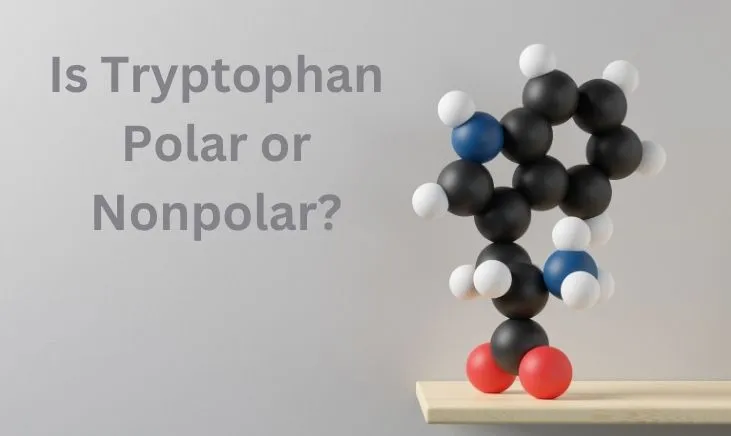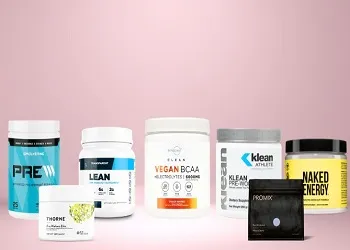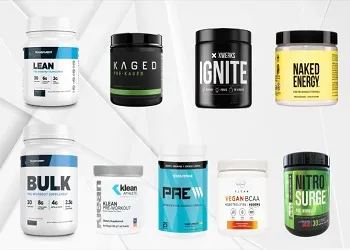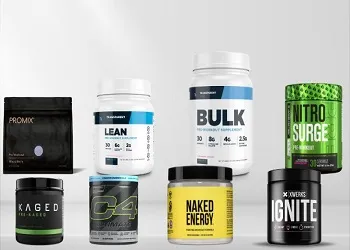Tryptophan is an essential amino acid that cannot be synthesized in the body. It must come through supplements or diet. As a largely nonpolar amino acid, tryptophan has an aromatic side chain, showing its hydrophobic nature.
Quick Look
- Tryptophan is an essential proteinogenic amino acid that regulates sleep, mood, and pain.
- The polarity of a molecule depends on the properties of its side chain.
- Tryptophan contains an aromatic side chain with polar and nonpolar properties, making it a largely nonpolar molecule.
- Tryptophan is sometimes categorized as amphipathic due to its ability to form hydrogen bonds weakly.
Table of Contents
What Is Tryptophan?

With a molecular weight of 204.22 g/mol and a molecular formula of C11H12N2O2, tryptophan is the largest proteinogenic amino acid, meaning it’s used in the body to produce functional proteins. Tryptophan is also classified as an essential amino acid, as it’s not synthesized from simple molecules and is dietarily essential.
Tryptophan, sometimes referred to as L-tryptophan, is known for its role in supporting mood; it helps to regulate mood due to its ability to produce and naturally balance specific hormones.
How does it do this?
Tryptophan is converted to its first byproduct, 5-HTP (5-hydroxytryptophan), and other key molecules, such as 5-HT (serotonin) and melatonin. On its own, 5-HTP plays important roles in neurologic and metabolic diseases. Conversion to serotonin, a monoamine neurotransmitter, regulates mood, cognition, reward, learning, memory, sleep, and other essential physiological processes. Serotonin is known as “the happy hormone” and is released when we feel good. It’s also the same chemical released when you consume certain comfort foods, which is why some research suggests tryptophan supplementation can help control appetite and may contribute to easier weight loss or weight management.
As a precursor to 5-HTP and serotonin, tryptophan is also involved in:
- Sleep
- Mood
- Emotional well-being
- Pain tolerance
Apart from serotonin and melatonin, tryptophan also serves as a precursor molecule for several bioactive compounds, including:
- Nicotinamide (vitamin B6)
- Tryptamine
- Kynurenine
- 3-hydroxykynurenine
- Quinolinic acid
- Xanthurenic acid
Key takeaway: Tryptophan is an essential amino acid converted into 5-HTP, serotonin, and melatonin. It plays a significant role in supporting mood, cognition, sleep, and other physiological processes.
Health Benefits of Tryptophan
- Promotes Better Sleep Quality

Are you tired of tossing and turning at night? Tryptophan might help. As the precursor to melatonin, the hormone responsible for regulating circadian rhythm and sleep patterns, tryptophan supplementation may benefit people struggling with sleep disturbance and insomnia.
Here’s some evidence to support it:
- A 2003 study published in the Journal of Psychiatry and Neuroscience found that 1 gram of tryptophan taken 45 minutes before bed could decrease sleep onset in people with mild insomnia and those with a long sleep latency. It also had no impact on sleep architecture and no effects on next-day alertness.
- An older study published in The Journal of Nervous and Mental Disease found that 250 mg of L-tryptophan increases deep sleep in patients with insomnia.
- A 1983 study found that tryptophan supplementation could also improve symptoms of obstructive sleep apnea (airflow blockage during sleep). Researchers found tryptophan supplementation increased sleep in people with obstructive sleep apnea during non-REM sleep. That said, there were no improvements in people with central sleep apnea.
A more recent study published in 2021 found similar results, suggesting that supplementing with at least 1 gram of tryptophan at night can improve sleep quality.
- May Improve Mood and Reduce Symptoms of Anxiety and Depression

Not only can tryptophan supplementation help improve your sleep, but studies have also shown that it can boost your mood and naturally protect you against depression, anxiety, and other stress-related symptoms.
As a hormone precursor, L-tryptophan converts to serotonin in the brain and can increase the availability of other amino acids, thereby promoting a more balanced mood and reducing the synthesis and release of stress hormones. This is based on evidence suggesting that tryptophan exerts effects on other neurotransmitters and CNS compounds—tryptophan supplementation has been shown to increase levels of dopamine, norepinephrine, and beta-endorphin, and modulate the endocrine system and cortisol, the stress hormone.
Other research suggests low tryptophan intake can lead to significant reductions in certain brain activities that promote happiness, and people who struggle with anxiety and depression display low serotonin levels. However, increasing dietary tryptophan can lead to less depression, irritability, and anxiety.
- Reduces Headaches and Migraines

Research suggests that low tryptophan levels can exacerbate pain associated with tension headaches and migraines, along with aggravating other symptoms of migraines, like nausea and sleep disruptions.
Studies show that boosting brain synthesis of serotonin may offer natural relief for headaches and migraine symptoms, including sensitivity to light, indigestion, and pain. A 2019 study published in Neurological Sciences found that subjects with a median intake of almost one gram of tryptophan per day reduced the chance of developing a migraine by nearly 60%.
Key takeaway: Tryptophan supplementation has been shown to benefit sleep through its role in serotonin and melatonin synthesis. It can also boost mood, reduce the risk of developing depression and anxiety, and reduce pain and various symptoms associated with headaches and migraines.
Polar vs Nonpolar Molecules
Because the core structure of all amino acids is the same—a chiral carbon, an amino group, a carboxyl group, and an R-group—polar and nonpolar amino acids are differentiated based on their side group.
But before we can understand if amino acids are polar or nonpolar, we first need to understand what this means.
- Nonpolar molecules: Nonpolar molecules are hydrophobic amino acids, meaning they are “water-fearing” or are insoluble in water. For example, if you add oil to water, you’ll quickly notice the oil pools on top because oil is hydrophobic.
- Polar molecules: They are hydrophilic, meaning they are “water-loving.” For example, adding sugar to water will dissolve—simple sugars are hydrophilic molecules thanks to their numerous polar hydroxyl groups.
Molecules are classified as polar or nonpolar based on the charges on the atoms bonded together to form the molecule.
Think back to your chemistry days. All atoms have a nucleus that contains neutral neutrons and positive proteins, with negative electrons floating around. Protons have a positive charge that draws electrons in—negative and positive charges attract.
When two atoms bond together, they share electrons. If two atoms of the same element have equal positive charges, they do not steal electrons from one another, resulting in no charge—these are nonpolar molecules.
When atoms of two different elements bond, one will inevitably have a higher charge and attract more electrons—this means the molecule is charged (polar). That charge is classified as either positive or negative.
When amino acids bond together to form proteins, only their side chains interact with one another and their surroundings. The protein’s shape is determined primarily by the sequence of amino acids in that chain.
- Nonpolar amino acids have hydrophobic side chains (R-groups), meaning they have side chains that repel water. As such, these amino acids are located in the core of the protein, away from contact with water.
- Polar amino acids have hydrophilic side chains, meaning they’re attracted to water and actively participate in hydrogen bonding with the highly polar water molecules. Because they are hydrophilic, these amino acids are generally located on the surface of proteins where they come into contact with the aqueous cell environment.
Let’s break that down further.
Polar Amino Acids
Amino acids are grouped based on their R-group or side chain. Polar amino acids have a partial positive and negative charge, making them hydrophilic (water-loving). This polarity arises due to the presence of specific functional groups in their side chains, such as:
- -OH (hydroxyl)
- -NH2 (amino)
- -COOH (carboxyl)
- -SH (sulfhydryl)
Polar amino acids include:
- Arginine
- Asparagine
- Aspartate
- Glutamine
- Glutamate
- Histidine
- Kysine
- Serine
- Threonine
- Tyrosine
Nonpolar Amino Acids
Nonpolar amino acids typically have a side chain that lacks polar bonds—their side chains are usually made of primarily hydrocarbons (hydrogen and carbon) and remain uncharged. This arises from the presence of specific R-groups, such as:
- -CH₃ (methyl)
- -CH₂CH₃ (ethyl)
Nonpolar amino acids include:
- Alanine
- Glycine
- Isoleucine
- Leucine
- Methionine
- Phenylalanine
- Proline
- Tryptophan
- Valine
Tryptophan Structure
Now that you understand polar and nonpolar molecules, we can look at the structure of tryptophan to determine its polarity.

As you can see, the side chain on tryptophan is aromatic—aromatic amino acids are hydrophobic and tend to reside in the protein core or transmembrane segments of proteins where they don’t come into contact with water.
Is Tryptophan Polar or Nonpolar?
Based on the structure of tryptophan, it is a nonpolar and hydrophobic amino acid. Research shows that tryptophan and other nonpolar and hydrophobic amino acids like phenylalanine and tyrosine tend to pack tightly within the hydrophobic protein interior and play an essential role in driving rapid protein folding and scaffold stability.
However, tryptophan isn’t an entirely nonpolar molecule.
Tryptophan contains a nitrogen atom in its indole ring. Although nearly always found buried in the hydrophobic interior of proteins because they are predominantly non-polar in nature, the polar atoms in tryptophan allow it to have weak hydrogen bonds with other residues or solvent molecules. As such, tryptophan can sometimes be classified as amphipathic.
Frequently Asked Questions
Is tryptophan hydrophobic?
Tryptophan is a predominantly hydrophobic amino acid found in the core of proteins. The aromatic side chain also means that tryptophan is involved in stacking interactions with other aromatic side chains.
Is tryptophan polar?
No. Although the N-H group in tryptophan is polar, the rest of the molecule is nonpolar, making tryptophan a largely nonpolar molecule. Some experts may classify tryptophan as an amphipathic molecule, meaning it is both polar and nonpolar.
Which amino acids are polar and nonpolar?
The polar amino acids include arginine, asparagine, aspartic acid (aspartate), glutamine, glutamic acid (glutamate), histidine, lysine, serine, and threonine. The nonpolar amino acids are alanine, cysteine, glycine, isoleucine, leucine, methionine, phenylalanine, proline, tryptophan, tyrosine, and valine.
How do you know if an amino acid is nonpolar polar?
The polarity of an amino acid is based on its side chain. If the R-group is hydrophilic, the amino acid will be polar; if the R-group is hydrophobic, the amino acid will be nonpolar. Polar side chains will typically contain one of the following functional groups: -OH (hydroxyl), -NH2 (amino), -COOH (carboxyl), -SH (sulfhydryl).














